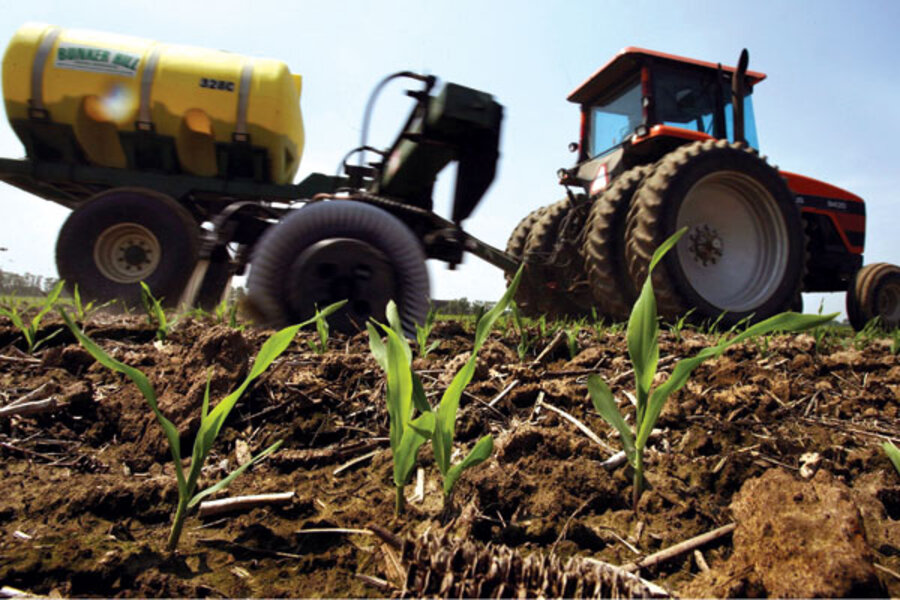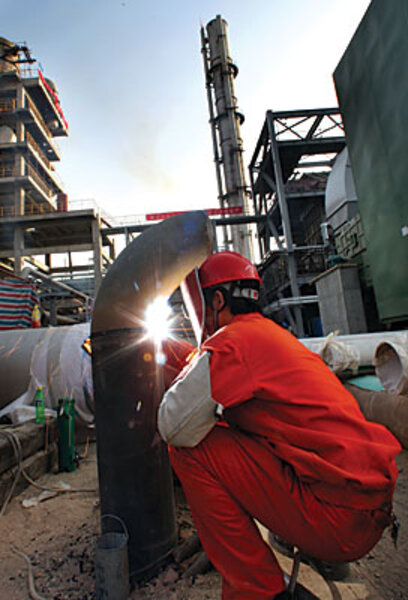Earth's growing nitrogen threat
Loading...
Dennis Lindsay still recalls the day four decades ago when his father, an Iowa farmer, began using nitrogen fertilizer on the family’s 160 acres.
With nitrogen, the family’s corn crop suddenly grew much higher and stronger, and produced full ears and big harvests. When fed to their cows and pigs, that high-quality corn produced far more milk and meat. As a result, the family bought more livestock – and the farm grew. “I remember Dad bringing the neighbors over to see how much greener and better the quality of the stalk was,” Mr. Lindsay says. “It was a really big deal then.”
It’s an even bigger deal today. Lindsay and his son farm 3,000 acres of corn and soybeans, using about 150 tons of nitrogen fertilizer annually. Farmers from China, Europe, and South America rely on nitrogen, too, to make ends meet and feed a growing world.
Yet it’s also becoming clear that too much of a good thing can have a downside for the environment. The world is awash in man-made “reactive” nitrogen (the chemically active form), researchers say.
While greening farms worldwide, much nitrogen washes into lakes, rivers, and the sea, causing rampant algae growth. More nitrogen billows from power-plant smokestacks, blowing in the wind until it settles as acid rain. Still other nitrogen gases remain in the atmosphere consuming the ozone layer. Nitrous oxide is nearly 300 times as potent as carbon dioxide – considered the leading cause of climate change – and the third most threatening greenhouse gas overall.
Last year, reactive nitrogen was identified as one of nine key global pollution threats and second worst in terms of having already exceeded a maximum “planetary boundary,” according to a study reported in the journal Nature.
“Nitrogen plays a tremendously important role in feeding the world’s peoples, so that’s a very positive benefit for humanity,” says James Galloway, a professor of environmental science at the University of Virginia, Charlottesville, and a leading nitrogen researcher. “The problem is how to maximize nitrogen’s benefits while diminishing its negatives – especially waste.”
Africa is one of a few places in the world where wider use of nitrogen fertilizers makes sense to help feed the population, many researchers agree. In the US, however, as much as 40 percent of reactive nitrogen is wasted – washing off farm fields into rivers, lakes, and the ocean, where oxygen-depleted “dead zones” are growing in number and size worldwide.
The situation is even worse in China, which uses about twice as much nitrogen fertilizer as the US to yield about the same amount of crops. As much as three-quarters of all nitrogen used to grow rice in China may be wasted, says Vaclav Smil, a nitrogen expert at the University of Manitoba in Winnipeg.
Vehicle exhaust, power-plant exhaust, and large-animal feeding operations are all sources of nitrogen emissions. Rising energy needs have meant more nitrogen oxides (NOx) – implicated in smog, acid rain, and global warming – emitted from fossil-fueled power plants.
Most nitrogen doesn’t stay in the atmosphere the way carbon dioxide from fossil fuel does, but precipitates out within a few days. Ammonia – a mixture of hydrogen and nitrogen – becomes ammonium when mixed with water and acts like fertilizer when it falls to the ground in rain.
Researchers have found major growth in ammonium in air quality data across 15 US National Parks, including Rocky Mountain, Yellowstone, Mount Rainier, and Canyonlands parks, the Associated Press reported last summer. At high altitude, delicate alpine tundra is being replaced by nitrogen-loving grasses, which are fed by growing amounts of ammonium falling as rain.
“The more nitrogen that we use in agriculture or that comes from various combustion processes – cars or power plants – the more ends up in the world’s ecosystem,” says Lester Brown, president of the Earth Policy Institute in Washington. “By altering concentrations of this key nutrient in the system, we are altering that ecosystem in many, many ways.”
Other researchers have spotted invasive grasses that thrive on nitrogen sprouting up in the Mojave and Sonoran deserts. Beside threatening other plant species, such grasses fuel wildfires.
But the most dramatic impacts can be seen in the growth of coastal dead zones where excessive nutrients in the water – fueled by runoff of fertilizers – has suffocated or driven away ocean animals. In the Gulf of Mexico, fish and shrimp have been eliminated in an 8,000-square-mile dead zone at the mouth of the Mississippi River. More than 400 dead zones with a total area of 245,000 square kilometers were identified worldwide last year.
There is reason for hope, however. If new EPA clean-air standards move ahead, then 90 percent of US NOx emissions from stationary sources could be eliminated. That’s because the two-thirds of US power plants that do not now have nitrogen-removal equipment could get it beginning by 2011, says John Walke, clean air director for the Natural Resources Defense Council in Washington.
Efforts to boost the efficiency of nitrogen use in farming are on the march, too. In Pennsylvania, for example, more than 100 farmers are using new tools to determine precisely how much to apply.
“Getting nitrogen right is critical for getting climate change right, food security right, and a lot of issues associated with poverty that have to do with nutrition depletion,” says Bill Herz, vice president of scientific programs for the Fertilizer Institute, a Washington trade organization that represent North American fertilizer manufacturers.
This spring, a federal science advisory report is expected to recommend a national goal of improving the efficiency of farm nitrogen fertilizer use by 25 percent, Herz and Galloway say.
That’s just fine with Mick Lane, spokesman for the On-Farm Network of the Iowa Soybean Association. In 2000, about 40 farmers across the state learned how to use nitrogen fertilizer more sparingly. Now the number is 500 and growing.“ We’ve seen an overall decrease in the amount of nitrogen with no negative impact on farm income,” he says.
That’s also true for Lindsay, the Iowa farmer. Using sophisticated digital systems to monitor how much grain is produced on which acres, he’s cut the amount of nitrogen he uses from more than 200 pounds per acre a decade ago to about 160 pounds.
“I’m just one of hundreds of farmers doing this, trying to use less nitrogen,” he says. “I want the environment to be good, too. We drink the water out here, and we want everything to be safe.”
Editor’s note: The Monitor's Environment section has a new URL. And there's also a new URL for our Bright Green blog. We hope you'll bookmark these and visit often.






